Author Archives: Stratified
Protected: Stratified Ford EcoBoost STOCK TURBO Flash Tune User Manual
Focus RS Power and Turbo Upgrade Considerations
Some things to consider when upgrading your Focus RS’ turbo and shooting for higher power numbers:
- The OEM turbo will sit between 350-375whp (to the wheels) on most cars with high quality 93 octane pump gas.
%20Pump.jpg)
- The OEM turbo when paired with E30 fueling or WMI will allow up to low 400whp level.
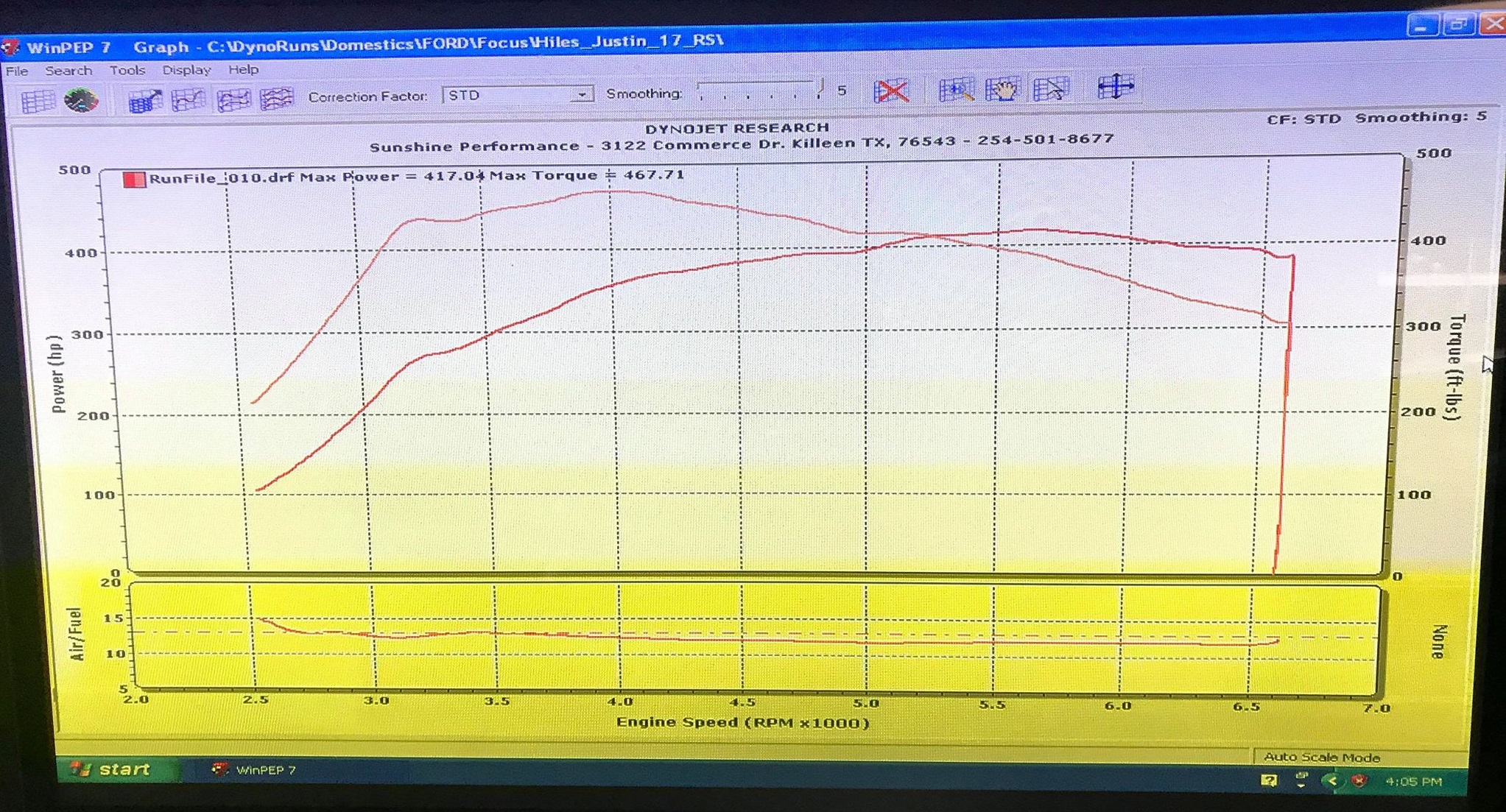
- At the 400-410whp level the OEM fuel system starts to reached its maximum flow capacity and an upgrade is recommended.
- With a larger turbo such as the NX2 on a stock motor, you will reach around 380-400whp on pump gas before reaching the knock limit.
- Adding ethanol will allow significantly more power on this turbo but you will need additional fuel system upgrades such as aux fuel to support this.
- Once you have addressed the turbo and fueling then you can push power on the stock motor beyond 500whp with something like an NX2 turbo.
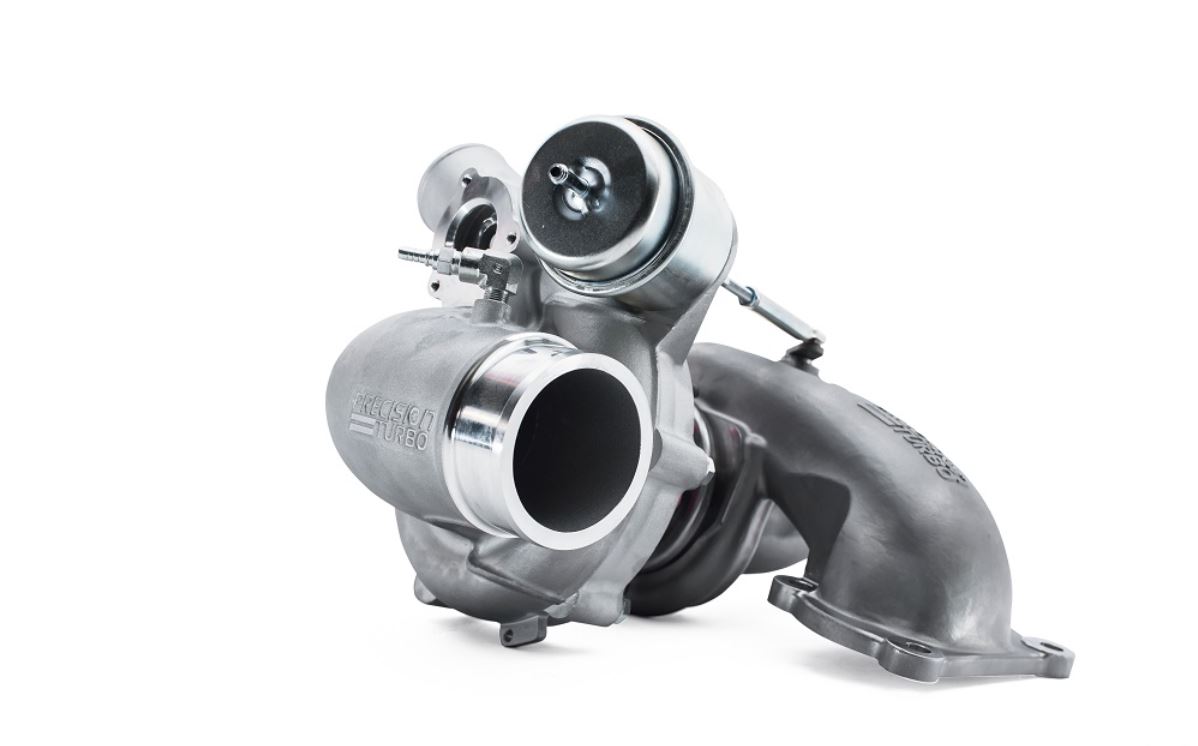
- Keeping power levels in the 425-450whp will extend the life of an OEM motor. You can achieve more power but the more torque the rods experience the fewer cycles they will last.
- At power levels exceeding 450whp supporting modifications on top of the usual flow bolt-ons (intercooler, exhaust, intake) will be needed such as a clutch and a 3.5 or 4 bar TIP sensor.
- Keep in mind that larger turbos do have a bit of a spool penalty with the NX2 spooling a couple hundred RPM later.
Considering the overall performance per dollar equation, the stock turbo with something like E30 or WMI tuned correctly is a great stock motor option. The NX2 or other turbo upgrades (there are higher performing, pricier options as well) make sense when you can run that high octane fuel AND have a fuel system upgrade.
For more power on pump gas than around 400whp, a better flowing motor is needed and that means cams. We were able to achieve 500whp on pump gas on a built motor with an externally gated 3076 turbo with upgraded cams.
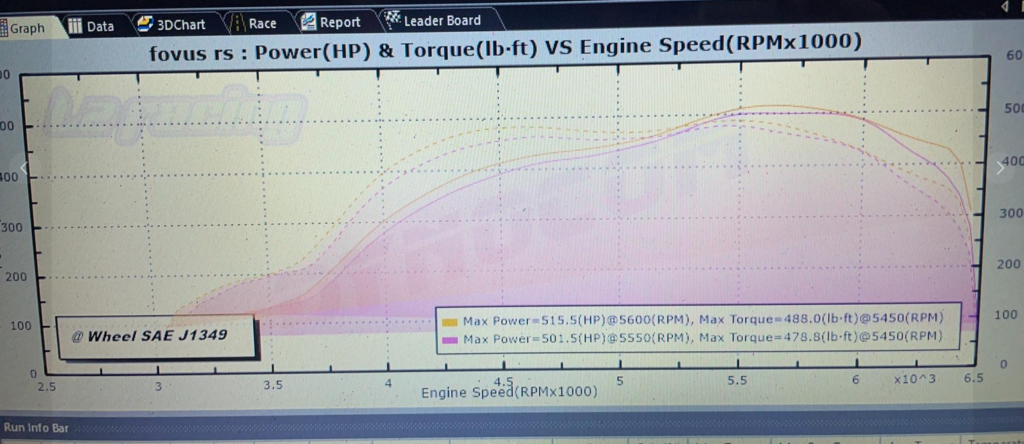 Once the motor is built and fuel system upgraded you can of course push higher with higher octane fuels.
Once the motor is built and fuel system upgraded you can of course push higher with higher octane fuels.
A final note – consider the use of the car. If you want a fun street machine you can pile on the power with just the aforementioned upgrades. However if you want the RS to last on a road course with significantly higher power levels you will want to address engine cooling, the RDU, brakes, suspension and of course tires. So build for your purpose and enjoy the journey!
Happy Tuning!
The Stratified Team
How the Ecoboost Works to Turn your Throttle Input into Torque Output
In the software on the ECU, there are multiple targets and limits for managing power output. The most commonly employed targets and limits will be based on torque, load, and boost.
Load and torque are closely related and they are modelled inside the ECU. Ford calls this modelling technique HDFX and it takes into account the variable cam timing of the engine. The model turns a pressure signal from the MAP and TIP pressure sensors into and air mass measurement since the car does not have a MAF sensor. This is important as for example, you will see higher calculated torque and load during cooler weather for the same boost level simply because the air has a higher density and the turbocharger flows more air mass at the same pressure.
Boost is simply that – pressure inside the manifold.
The airflow modelling has to be accurate and the model has to be tuned depending on what modifications are installed (different turbo, cams, etc). The result of this model is used everywhere – from torque targeting to spark timing to fueling.
Now, when you press the throttle, there is a torque request that then gets turned into a load request that then turns into an airflow request that then turns into a pressure (boost request) that then gets passed onto the turbocharger model and wastegate is calculated and adjusted. Whew … as you can see everything cascades down so errors along the way will also get propagated.

All this modelling must then translate into a control of the torque. There are several mechanisms to control the torque output and wastegate, the electronic throttle, and spark timing are used together. Controlling boost only using the wastegate is much slower to react than also involving the throttle, and the throttle is much slower than spark timing. Having the correct targets and limits in place for each will allow the ECU and motor to be responsive and smooth. It will also catch issues such as a line popping off the wastegate for example by closing the throttle. This will happen both at part throttle and wide open throttle.

The responsibility of the tune is to ensure that both the internal models, targets and limits are set appropriately and accurate. This results in smooth engine response to throttle input. This also avoids dangerous operating conditions such as boost that is too high due to a mechanical failure or otherwise. (Check out this article for more insight)
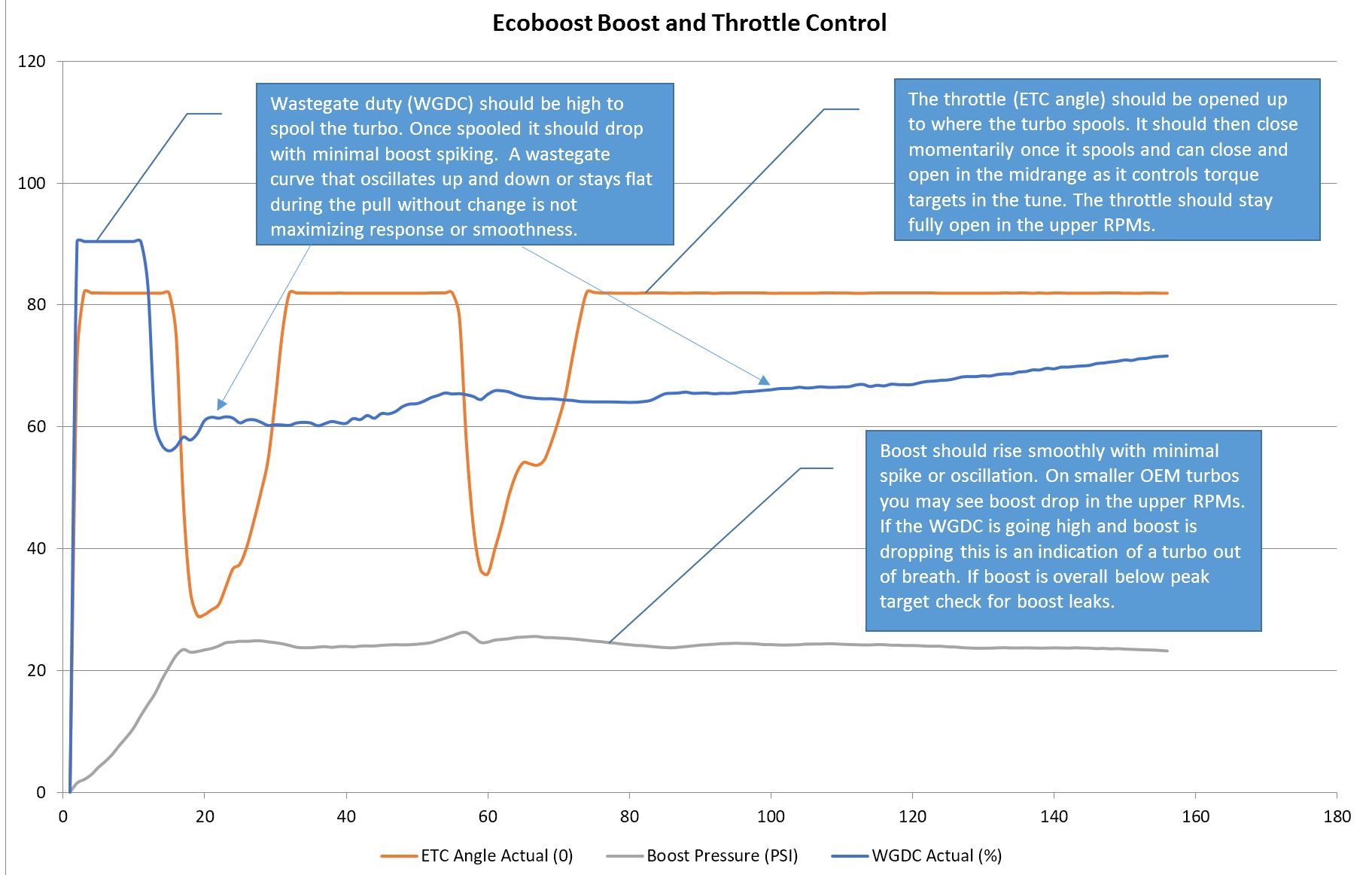
All the tunes we build have these principles baked in – from flash to custom – because having them all come together delivers both performance and driveability (this is believe it or not the harder one to get right) for the entire power band and driver inputs.
Happy Tuning, The Stratified Team
Keeping the Tuned Ecoboost 2.0 Alive (and kicking butt)!
I want to shed some light on the Ecoboost 2.0 piston failures (the most common failure mode) and offer some pointers on keeping the OEM motor happy and living.
Let’s get one thing out of the way first – the weak point in the EB 2.0 is clearly the piston. Failures happen on stock engines, tuned engines – even ones tuned by Ford Performance! We don’t see failures like this in the 1.6 and 2.3 engines and Ford has made a point of reinforcing ringlands on the 2.3 EB. The 2.3 is more likely to toss a rod before a piston falls apart. Every engine has a weak point.
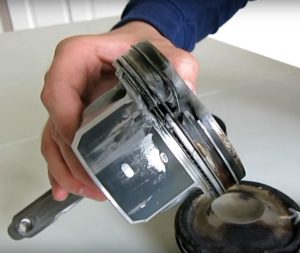 Now that this is out of the way – let’s look at what makes the engines fail and how to make it less likely for it to happen to your Ecoboost!
Now that this is out of the way – let’s look at what makes the engines fail and how to make it less likely for it to happen to your Ecoboost!
Fuel and Air Fuel Ratios
The car uses full time closed loop fuel control using a wideband O2 sensor. That means it is always adjusting the air fuel ratios (part throttle and wide open) to match what is being commanded in the tune. Using a speed density strategy (using pressure sensors to infer air mass consumed by the engine) makes the air fuel ratios unaffected by charge air leaks that would throw MAF based cars off. Having looked at 10s of thousands of datalogs from these vehicles, we almost never see them deviate from target air fuel ratios. The only exception is if there is an exhaust leak that draws oxygen into the exhaust stream “fooling” the wideband sensor. If severe enough this will trigger a “lean” running CEL. Check and fix exhaust leaks (and boost leaks for the sake of performance).
Carbon buildup often interfere with injector spray patterns. Cars driven in traffic and idled for long periods of time are more prone to this. Consider an injector cleaning or replacement as the engine gets up in age past 60,000 miles.
Boost
In terms of boost pressure – the OEM turbochargers have a very weak wastegate spring with a large internal wastegate. This in turn means that boost will taper regardless of what you do electronically with the OEM wastegate actuator. This prevents overspeeding of the turbo and boost is held at peak values for a very short section of the power band (tapering starts just past 4000 RPM and tapers to 13-16psi by redline). The OEM intercooler is not designed for performance and extended high gear, high load conditions will warrant an intercooler upgrade. Changing your wastegate actuator or turbo definitely requires a retune so don’t make these changes without having tuning handled as well.
Spark and Knock
“Normal spark knock” is very well handled with the OEM knock control system. You never see pistons pitted from detonation when taking the engines apart as the ECU if setup correctly is very fast to react and again if setup correctly effective at adjusting for variance in driving conditions and octane levels. The most common spark related issues are spark plugs. Consider them a maintenance item and replace spark plugs every 20,000 miles on a tuned engine. Replace them with a step colder plug gapped at 0.026″. Failing to do so will cause misfires which add to carbon deposits.
How the knock detection system works
If you got this far excellent; I am going to get into the issues that cause these cars to fail as we observed from working with them over the years.
Common Failure Modes and Avoiding Failure
1. LSPI – low speed pre-ignition. The common killer of downsized highly boosted direct injection engines. A concoction of oil blowby, carbon buildup, high torque, oil formulation, injection spray pattern will cause the mixture to pre-ignite and be immediately followed by what is known as super knock. That means that the mixture will ignite well before the spark plug is triggered by the ECU. The chain of events that follow will quickly destroy a piston as the expanding hot combustion event will push down on an upward moving piston. It only has to happen a few times. The most common time this will happen is when you have been cruising on the highway and then punch the throttle or get into boost quickly. Remember the car will build a lot of boost even at part throttle.
The hot engine in combination with a lot of PCV oil flow make the scenario much more likely. This is the reason you often don’t see these engines failing at wide open throttle. During an LSPI event you can get an outright failure or you get a crack that will eventually lead to the failure at what appear odd times. There are many ways to mitigate LSPI but the fundamental reason for it is ingrained in the design of the motor. Things like water-methanol injection, added port injection, carbon cleaning, using high quality oil and changing it often (there are now oil formulations designed to be more pre-ignition resistant) and good intercooling go a long way. This first part comes down to keeping the engine cleaner and cooler.
This engine when tuned will makes the majority of its torque in the lower range of the power band with an OEM turbo. That’s simply a physical fact from the way the engine and turbocharger are designed. This is the operating zone associated with LSPI. Keep this in mind and AVOID getting into boost right away after you have cruised on the highway for some time. Downshift, ease into boost, build it gradually and then get into it. After this initial time easing into it, have a blast going through the gears! I also recommend to avoid loading up the motor in the low RPM range and a high gear in general – downshift if you are under 3000 RPM on the highway and you need to make a pass.
Don’t confuse this with not driving the car hard. Cars that survive the longest are often well exercised. Run it through the gears in boost and allow some of the oil and carbon residues to burn up.
2. Another scenario that is hard on the rotating assembly – rods and pistons – is sitting on a rev limiter. Launch Control, Redline Rev Limiter, Flat Foot Shift Limiter all work the same way. The OEM logic for this cycles cylinders on and off to maintain a certain engine speed by shutting off fuel and ignition temporarily on some cylinders. However the acceleration and deceleration of the rotating assembly is hard on the components. This often triggers the knock sensors also indicating the resonance created by this activity (slap and lash) is similar to detonation events and unhealthy for the motor.
Sitting on limiters excessively for public displays is not doing the motor any favors. We offer crackles which are NOT achieved by adding any fuel or energy to the engine. We are careful to implement these in an OEM-like fashion (common in other makes like VW, Porsche, even the Focus RS). Let me be clear, the crackles are NOT an invitation to be abusive to the motor if you want it to last. So, sorry for all those who ask but we don’t and won’t purposefully make the cars shoot flames.
The engines are not inherently weak and we have customers with hundreds of track lapping days on OEM motors making 350-400whp on larger turbochargers. The motors survive. I recommend reading some of the tech literature we have on our site meant to help you, the enthusiast. With an Accessport in your hand you can view and datalog a lot of tuning parameters for yourself including air fuel ratios, boost, knock, charge air temperatures and those articles teach you how to interpret most of these. If you have questions or want us to perform datalog reviews get in touch – we offer these for every car we tune!
Enjoy the cars, tune them well, operate them wisely, and be familiar with these excellent machines, their weak and strong points.
More articles below:


.JPG)
